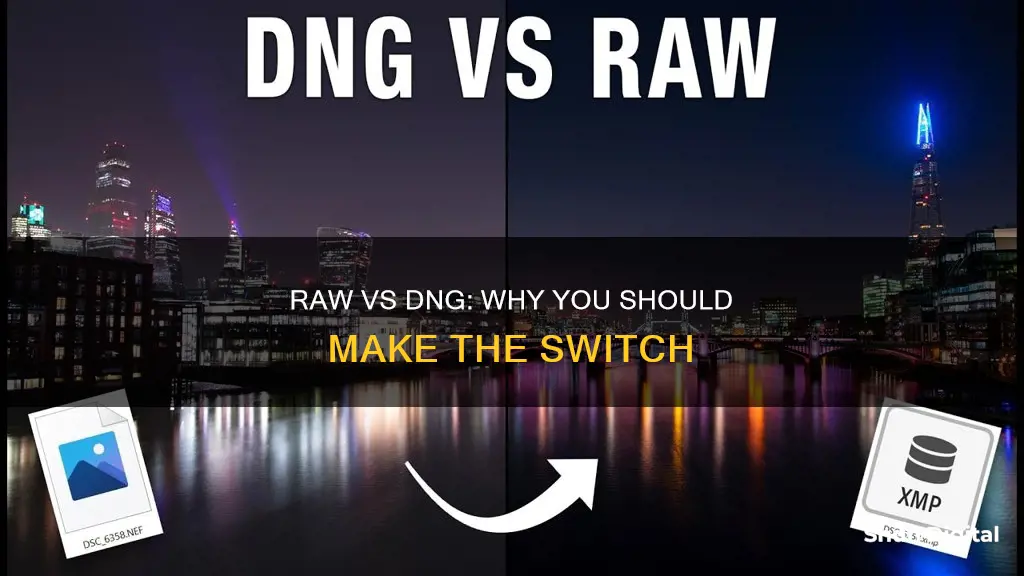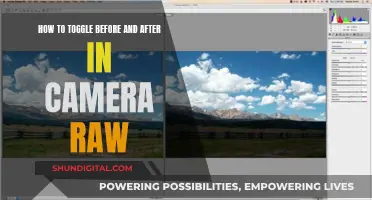
The Digital Negative (DNG) is a free, openly published raw file specification developed by Adobe to address the lack of an open standard for the proprietary and unique raw files created by each digital camera. The DNG format is designed to be a universal archival format for raw files, allowing photographers to easily access and catalogue their files. It also promotes archival confidence, as it can be easily adopted by camera manufacturers and updated to accommodate technological changes.
| Characteristics | Values |
|---|---|
| File format | Digital Negative (DNG) |
| File type | Raw image |
| File extension | .dng |
| Developed by | Adobe |
| Purpose | Archiving or exploitation of camera raw image files |
| Supported cameras | 350+ types, including Canon, Kodak, Olympus, Ricoh, Samsung, Panasonic, Sony, Sigma, Nikon, and Fujifilm |
| Benefits | Image preservation, easing the work of software developers, avoiding incompatibility problems, etc. |
| Specification | Freely available to hardware and software vendors |
| Software support | Photoshop, Photoshop Elements, Lightroom, and Lightroom Classic |
| Converter | Adobe DNG Converter |
| Converter features | Batch processing, compression settings, compatibility mode, original raw file embedding |
What You'll Learn

File management is simplified
When editing a camera raw file, the edit settings are held in a separate XMP file, resulting in two files for every image. This can increase the chances of misplacing, losing, or corrupting files. In contrast, DNG files store edit settings within the file itself, resulting in a more organised and compatible way of working.
DNG is also beneficial for file management as it is a publicly available archival format for raw files. This means that photographers can access their files more easily in the future, even if their camera model becomes obsolete. With DNG, there is no need to worry about whether specific camera raw formats will continue to be supported by software applications.
Additionally, DNG allows for the addition of private metadata, which can be useful for file management and differentiation.
Overall, converting camera raw to DNG can simplify file management by providing a generic, widely compatible, and future-proof file format that stores all edit settings and metadata within a single file.
Charging Your Lumix Waterproof Camera: A Step-by-Step Guide
You may want to see also

Smaller file sizes
The Digital Negative (DNG) format employs lossless compression to reduce file size by around 20% without altering any of the original capture data. This means that, unlike with JPEG files, there are no compressed artefacts when using DNG.
For example, the raw files for a Canon 5D Mk III are 27MB in size, but become 24MB when converted to DNG.
The DNG format is also more efficient when it comes to handling raw files from multiple camera models and manufacturers. This is because DNG is a publicly available archival format that can be used and supported by any developer, whereas raw files are camera-specific and may not be readable by certain software applications.
DNG also allows for the addition of private metadata, enabling differentiation.
Dodge Charger GT: Reverse Camera Availability
You may want to see also

Future-proofing
DNG, or Digital Negative, is an openly published raw file specification that stores the "raw" pixel data captured by a digital camera sensor. It was developed by Adobe to address the lack of an open standard for the unique raw files created by each digital camera.
DNG is a future-proof file format for photographers. It is a standardised file format, so users can have confidence that they will be able to open DNG files in the future, unlike proprietary RAW formats. Hundreds of software manufacturers, including Apple and Google, have developed support for DNG. Respected camera manufacturers such as Leica, Casio, Ricoh, Samsung, and Pentax have introduced cameras that provide direct DNG support.
DNG files are designed to be universally accessible and do not require adherence to any one brand of processing software. They are also smaller in size than other RAW file types, saving storage space. Additionally, DNG files keep XMP metadata within the file, making it easier to ensure RAW adjustments are preserved.
Adobe provides the free Adobe DNG Converter, which easily translates raw files from many popular cameras into DNG format. Adobe Photoshop, Photoshop Elements, Lightroom, and Lightroom Classic all support DNG files.
To future-proof DNG files, it is recommended to keep two physical copies in different locations, such as a hard drive in the office and an external drive at home. One of these copies can also be stored on longer-lasting optical media such as a CD, DVD, or Blu-ray Disc. Additionally, users can utilise cloud storage solutions such as Amazon Web Services, Carbonite, or Dropbox.
Charging the WASP 4K Camera: A Step-by-Step Guide
You may want to see also

Single format for easy cataloguing
Photographers can use the Adobe DNG Converter to convert camera-specific raw files to a more universal DNG raw file. This allows photographers to archive their raw camera files in a single format for easy cataloguing and future access.
Different camera brands have different versions of raw files. For example, Canon's raw files are called CR2 or CR3, Nikon's are NEF, and Fuji calls theirs RAF. With DNG, photographers can unify their raw files into one generic file format. This makes it easier to catalogue and manage their digital assets.
With the DNG format, photographers don't have to worry about their raw files becoming obsolete in the future. It is a publicly available archival format that is supported by hundreds of software manufacturers, including Apple and Google. This means that photographers can easily access their files and won't be restricted by proprietary raw file formats that may become outdated.
The DNG format also helps to streamline the workflow when handling raw files from multiple camera models and manufacturers. Instead of dealing with various raw file formats, photographers can use a single raw processing solution, making their workflow more efficient.
In summary, converting camera raw files to DNG provides photographers with a single, universal format for their raw images, making it easier to catalogue, access, and manage their photo library.
Troubleshooting Guide: Lumix Camera Battery Won't Charge
You may want to see also

Open standard for raw files
Digital Negative (DNG) is a publicly available archival format for raw files generated by various digital cameras. It was developed to address the lack of an open standard for the proprietary and unique raw files created by each digital camera model.
The DNG format has several benefits. Firstly, it allows photographers to archive their raw camera files in a single format, making it easier to catalogue and access files in the future. Secondly, with the format specification freely available, any developer can build software that supports and takes advantage of DNG. This includes hundreds of software manufacturers such as Apple and Google, as well as camera manufacturers like Leica, Casio, Ricoh, Samsung, and Pentax, who have introduced cameras that provide direct DNG support.
Additionally, DNG helps promote archival confidence since digital imaging software solutions will be able to open raw files more easily in the future. It also enables a more efficient workflow when handling raw files from multiple camera models and manufacturers, as a single raw processing solution can be used.
The DNG format is also beneficial for hardware and software manufacturers. It removes a potential barrier to new camera adoption, as raw files from new models will be immediately supported by Photoshop and other applications. It also allows for R&D savings by reducing the need to develop new formats and simplifying camera testing. Furthermore, a common format allows greater control over the quality of conversions by third-party applications.
In summary, DNG is an open standard for raw files that offers advantages such as easier archiving, improved software and hardware compatibility, enhanced workflow efficiency, and cost savings for manufacturers.
Adjusting Midtones in Camera Raw: A Step-by-Step Guide
You may want to see also
Frequently asked questions
Digital Negative (DNG) is a publicly available archival format for raw files generated by various digital cameras. This means that photographers can easily access their files, unlike with proprietary raw files which are created by individual camera models and are not supported by all software applications.
DNG files can be read by a variety of software applications, including Photoshop, Photoshop Elements, Lightroom, and Lightroom Classic. Hundreds of software manufacturers, including Apple and Google, have developed support for DNG. DNG also allows photographers to archive their raw camera files in a single format for easy cataloguing and access in the future.
Respected camera manufacturers such as Leica, Casio, Ricoh, Samsung, and Pentax have introduced cameras that provide direct DNG support. Adobe's DNG Converter also enables you to convert camera-specific raw files from more than 700 cameras to DNG.
You can use the Adobe DNG Converter, a free utility that enables you to convert camera-specific raw files to DNG.
DNG conversion can increase workflow time, especially when dealing with large files or thousands of images. DNG also has limited compatibility with other software, so you may find yourself locked into using Adobe products.







